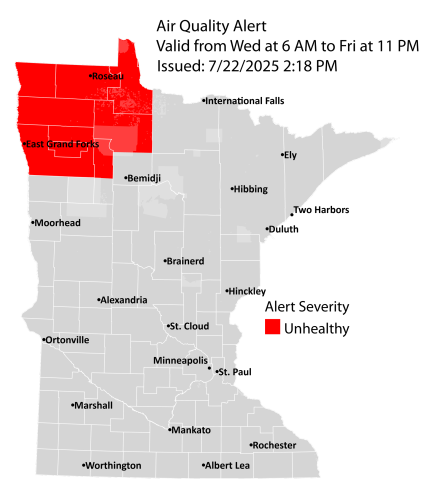
Air quality is expected to reach the red AQI category in northwest Minnesota, which is unhealthy for everyone.
The Minnesota Pollution Control Agency (MPCA) has issued an air quality alert for northwest Minnesota. The alert takes effect 6 a.m. on Wednesday, July 23, and runs until 11 p.m. on Friday, July 25. The affected area includes East Grand Forks, Roseau, and the Tribal Nations of Red Lake and White Earth.
A band of heavy smoke from wildfires in Saskatchewan and Manitoba is moving south across southern Manitoba and will reach northwest Minnesota by early Wednesday morning. A stationary front will remain over the northern part of the state for most of the day Wednesday, which will keep ground-level smoke confined to the northwest corner of the state. The front will move east and exit the region overnight and by Thursday morning northwest winds will be widespread across the state. This will allow smoke to move quickly southeast and smoke will reach northeast, central, and southwest Minnesota by Thursday afternoon. The alert will likely need to be expanded for Thursday. Air quality impacts will continue through Friday. Winds will become southerly Friday, which will push the smoke back to the north. Air quality should improve gradually from south to north beginning Friday afternoon.
Fine particle levels are expected to reach the red air quality index (AQI) category, a level considered unhealthy for everyone, across northwest Minnesota. This area includes East Grand Forks, Roseau, and the Tribal Nations of Red Lake and White Earth. In the red area, sensitive groups should avoid prolonged or heavy exertion and limit time spent outdoors. Everyone should limit prolonged or heavy exertion and time spent outdoors.